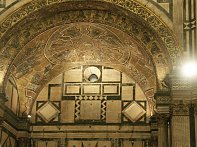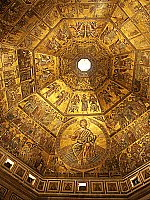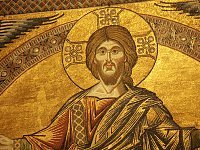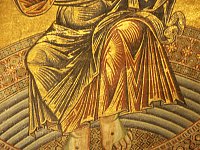

| Located on the Piazza del Duomo, the Baptistery is the oldest building there. See 18th century engraving of the Piazza by Giuseppe Zocchi. Scholars believe that a baptistery had been located on this site as early as the 5th or the beginning of the 6th century which was also no doubt an octagon.1 As Timothy Verdon explains, the octagon was an important symbolic shape for baptistries because of the "octava dies" or eighth day--the time of the Risen Christ. Baptism initiates the Christian into the faith and new life in Christ. Thus, the octagon alludes to the Christian hope of resurrection. This shape was common. See, for example, the earlier baptistery in Ravenna. The building is not only important for its spiritual significance; John the Baptist was in fact the patron saint of Florence. | ||

|
Entrance doorThree doors, all with bronze reliefs on the exterior, give access to the Baptistery. A fourth side, seen below, is the chancel or rectangular apse, known as the "scarsella." Geometric wall decorations are faint reminders of the art of migratory tribes, while the pavement designs recall Islamic art. The mosaics in the dome are influenced by Byzantine art. At the same time the domed space reminds one of the Pantheon while some architectural elements were actually cannibalized from classical art--columns and some of the marble wall cladding, for example. Thus the interior exhibits multiple influences. | |
| The interior walls, not just the dome, recall the Pantheon. Here the wall is divided into two stories with freestanding columns on front of recesses on the ground floor and pilasters on the second register. (See the center image below.) Both the Pantheon and the Baptistery are decorated with polychrome marble facings. | ||

|

|

|

|

|
The dome--25 meters in diameterThe mosaics were executed in the 13th century with those depicting John the Baptist probably done last (in the early trecento). The mosaics are significant both in terms of their extent and size and their important location. Some scholars assert that Florentine painting begins with this series of mosaics. |
The Last Judgment with Christ in GloryScenes of judgment occupy the three lower zones on three faces of the octagon. The gold background of the entire dome not only signifies wealth and value, but suggests a sense of permanence. This background is of course unnaturalistic but the entire sequence of scenes is traditional with conceptual images, not imitations of ordinary reality. Similarly, there is no interest in accurate scale; the size of figures is related to their importance. Modelling is stylized and gold striations in the drapery indicate folds in an unnaturalistic way. | ||

|

|

|
Continue to page 2.
See also Baptistery doors by Andrea Pisano.
See also Ghiberti's first set of doors (north doors).
See also Ghiberti's Paradise doors.
1Glenn Andres speculates that the Baptistery was built following the 7th century conversion of Queen Theolinda from Arianism to Roman Christianity and suggests that the San Giovanni Baptistery was modelled on the Arian Baptistery in Ravenna.
Works Consulted:
Timothy Verdon. [pamphlet distributed at the Baptistery]
Glenn Andres, John M. Hunisak and A. Richard Turner. The Art of Florence. New York [?]: Cross River Press, distributed by Abbeville Press, 1988.
 Click here to return to index of art historical sites.
Click here to return to index of art historical sites.
 Click here to return to index of artists and architects.
Click here to return to index of artists and architects.
 Click here to return to chronological index.
Click here to return to chronological index.
 Click here to see the home page of Bluffton University.
Click here to see the home page of Bluffton University.
